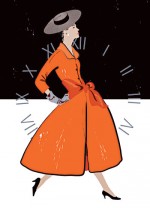Title
Subhead

One inspiration for the Juilliard Opera production of Massenet’s Cendrillon was this 1943 photo, director Peter Kazaras said.
(Photo by Esther Bubley)Banish notions of fairies in tutus and a pumpkin and mice transforming into a coach and coachmen. The Juilliard Opera’s production of Cendrillon, Massenet’s version of the Cinderella story, embraces the tale’s magic, but it’s an emphatically non-Disney sort.
Body
The opera, which premiered in 1899 in Paris and will be performed at Juilliard at the end of this month, ends with the fairy godmother and the spirits (fairies) talking about how the opera allowed them and the audience to escape from reality and believe in the fabulous. “The tension between reality and the world of the fairy tale was even more pronounced when Massenet conceived it,” Emmanuel Villaume, who will conduct the opera at Juilliard, told The Journal. Originally there was a prologue expressing that idea, and while that prologue doesn’t seem to have ever been performed, that “dichotomy between the real and the fabulous” is at the heart of this production, Villaume said.
And indeed, director Peter Kazaras has embraced that tension on many levels. For numerous logistical reasons, he said, it made sense to pare down the opera. Inspired in part by a 1943 photo by Esther Bubley of a lonely, determined-looking woman alone at a bar, Kazaras told The Journal he wanted it to be “about Cendrillon and her immediate experience and not as much about courtiers and hangers-on.” Instead, he began to conceive of it as being seen from the point of view of Cendrillon herself (sung in this production by soprano Julia Bullock).
Kazaras, who has followed a successful career as an operatic tenor with a burgeoning one as a stage director—he’s now the head of the opera studies program at U.C.L.A.—decided to set this production of Cendrillon in France in 1947. Fashion designer Christian Dior unveiled his New Look that year, but it was also a time of deprivation. Postwar food rationing was still in place and the winter was horrifically cold, meaning that food was power. Cendrillon’s father, Pandolfe (baritone Szymon Komosa), has remarried the coarse, striving Mme. de la Haltière (mezzo-soprano Avery Amereau), who has two equally coarse, striving daughters: sopranos Lila Heinrich Szász (M.M. ’13) and Marguerite Jones. Mme. de la Haltière owns a café and has gotten rich from black marketeering. She wants her daughters (though not the beleaguered Cendrillon, of course) to marry up—and conveniently the king (bass Önay Köse) is hosting a ball to find a wife for his son (mezzo-soprano Lacey Jo Benter; Massenet called for a falcon soprano or “soprano de sentiment” for the role). Cendrillon escapes her dreary lot—no ball for her!—at the local cinema.
“I thought, what is magic for us?” Kazaras recalled. “Movies. They allow an altered state of consciousness. They’re the secret place you go when you dream your dreams.” So the fairy godmother (soprano Elizabeth Sutphen) and her six spirits are the chief usher and the usherettes at the theater—and they provide Cinderella with the shoes that allow her to go to the ball. At midnight, she flees the lovestruck prince and goes back to the movie theater.
“Everything fell into place once we’d figured out the time and the cinema angle,” Kazaras said. The set morphs from a café to a palace with a few stops in between, and, finally, the movie house. “It’s a Donald Eastman design, so it’s gorgeous and elegant and provides a compelling visual framework that becomes part of the story,” Kazaras said. Still, “the emphasis is on the performers and it should be, which isn’t always the case nowadays. This production is about detailed work—it’s text and storytelling-oriented with this beautifully constructed score and gorgeous music.”
Villaume, who made his debut with the Juilliard Orchestra in 2008, has worked with Kazaras previously as a singer, though not as a director, but he’s not worried. “From the first conversation with a stage director, you know whether they’re prepared, and Peter is unbelievably prepared,” he said. “He’s got a lot of imagination and no b.s.—it’s a nice combo.”
And though Villaume has been talking with Kazaras and the Vocal Arts Department about the production since last summer, prior to arriving at Juilliard for rehearsals at the end of March, he had a wait-and-see approach to how things would work out. “When there is a strong concept from the stage director like this, I just try things and let it happen in rehearsal,” Villaume said. “I love Peter’s concept, and the tensions between the world of imagination and reality works very well with the cinema, because with cinema you always have that distance between the two,” he added. “I have to spend a few days with the musicians, and then I’ll be seeing how it’s all going to translate.”





